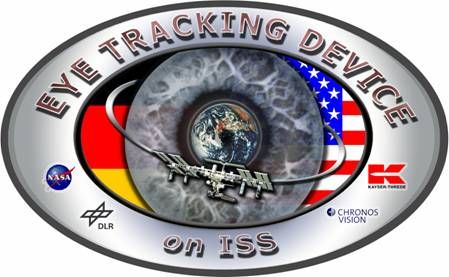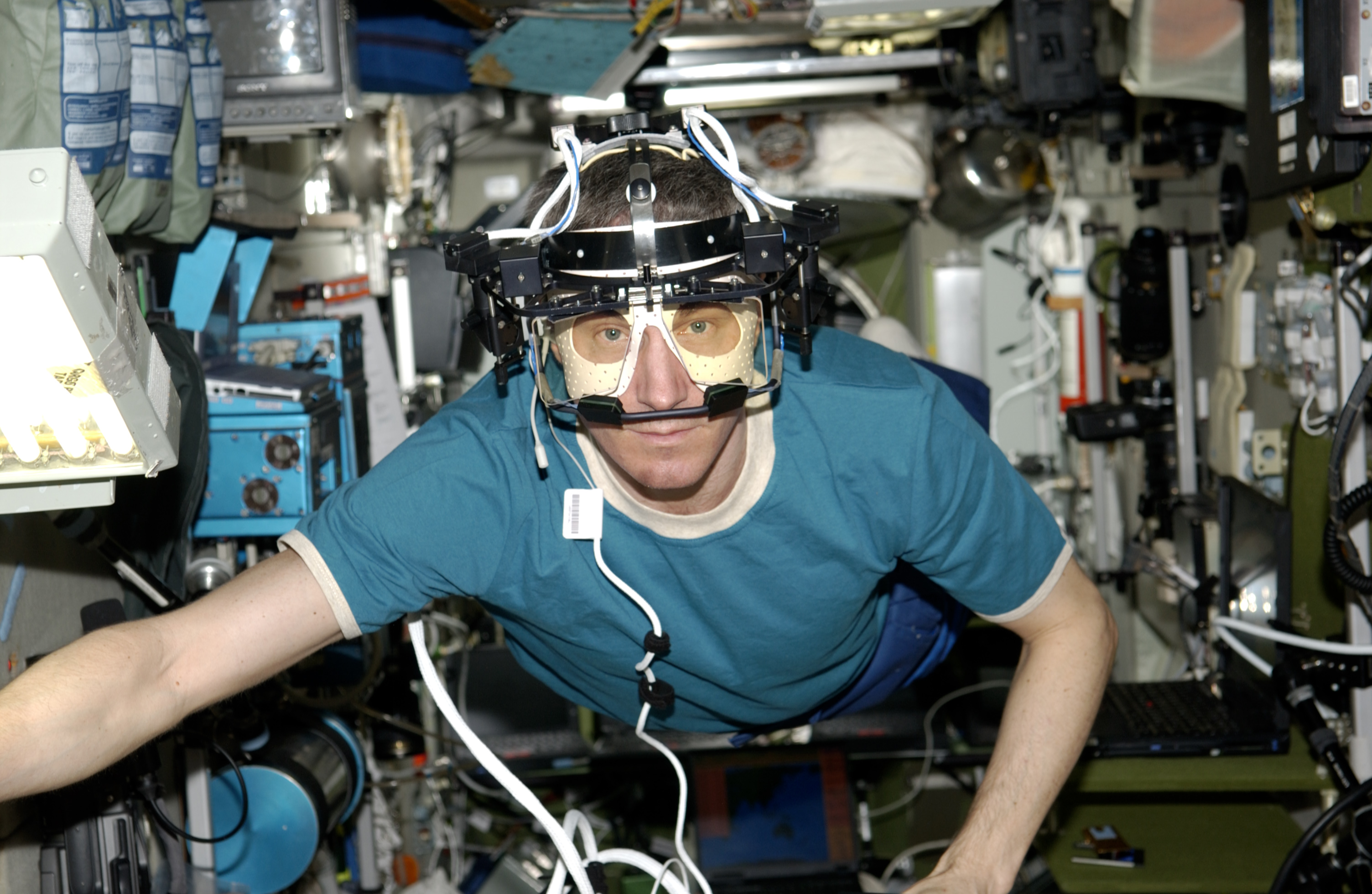Eye Tracking Device on:
[Wikipedia]
[Google]
[Amazon]
 The eye-tracking device (ETD) is a headmounted device, designed for measurement of
3D eye and head movements under experimental and natural conditions.
The tracker permits comprehensive measurement of eye movement (three degrees of freedom)
and optionally head movement (six degrees of freedom). It represents a tool for the investigation of sensorimotor behaviour, particularly of the
The eye-tracking device (ETD) is a headmounted device, designed for measurement of
3D eye and head movements under experimental and natural conditions.
The tracker permits comprehensive measurement of eye movement (three degrees of freedom)
and optionally head movement (six degrees of freedom). It represents a tool for the investigation of sensorimotor behaviour, particularly of the
 It was originally developed by the German Space Agency (DLR) for use on the International Space Station (ISS) and was uploaded to the station as part of the joint European / Russian space programme in early 2004. The device was designed by Prof. Dr. Andrew H. Clarke (Vestibular Lab, Charité Berlin) together with the companies Chronos Vision and Mtronix in Berlin and integrated for space utilisation by the Munich-based company Kayser-Threde.
In the first set of experiments, conducted by Prof. Clarke’s team in cooperation with the Moscow Institute for Biomedical Problems, the Eye Tracking Device was used for the measurement of Listing's plane – a coordinate framework, which is used to define the movement of the eyes in the head. The scientific goal was to determine how Listing’s plane is altered under various gravity conditions. In particular the influence of long-duration microgravity on board the ISS and of the subsequent return to Earth’s gravity was examined. The findings contribute to our understanding of neural plasticity in the vestibular and oculomotor systems.
These experiments were commenced in the spring 2004 and continued until late 2008 with a series of cosmonauts and astronauts, who each spent six months on board the ISS.
It was originally developed by the German Space Agency (DLR) for use on the International Space Station (ISS) and was uploaded to the station as part of the joint European / Russian space programme in early 2004. The device was designed by Prof. Dr. Andrew H. Clarke (Vestibular Lab, Charité Berlin) together with the companies Chronos Vision and Mtronix in Berlin and integrated for space utilisation by the Munich-based company Kayser-Threde.
In the first set of experiments, conducted by Prof. Clarke’s team in cooperation with the Moscow Institute for Biomedical Problems, the Eye Tracking Device was used for the measurement of Listing's plane – a coordinate framework, which is used to define the movement of the eyes in the head. The scientific goal was to determine how Listing’s plane is altered under various gravity conditions. In particular the influence of long-duration microgravity on board the ISS and of the subsequent return to Earth’s gravity was examined. The findings contribute to our understanding of neural plasticity in the vestibular and oculomotor systems.
These experiments were commenced in the spring 2004 and continued until late 2008 with a series of cosmonauts and astronauts, who each spent six months on board the ISS.
 Examination of the orientation of Listing's plane during the course of a prolonged space mission is of particular interest, as on Earth the Listing’s plane appears to be dependent on input from the vestibular system i.e. detected through the head position with relation to gravity. By exposing the astronaut to the weightlessness of space, this experiment can follow the subsequent adaptation of the astronaut’s vestibular system during the flight and after returning to Earth. The key question in this experiment is to what extent the orientation of Listing’s plane is altered by the adaptation of the vestibular system to weightlessness, or under gravitational levels less than or greater than those of Earth. A further question is whether the body compensates for the missing inputs from the vestibular system by substituting other mechanisms during long-term spaceflight.
Examination of the orientation of Listing's plane during the course of a prolonged space mission is of particular interest, as on Earth the Listing’s plane appears to be dependent on input from the vestibular system i.e. detected through the head position with relation to gravity. By exposing the astronaut to the weightlessness of space, this experiment can follow the subsequent adaptation of the astronaut’s vestibular system during the flight and after returning to Earth. The key question in this experiment is to what extent the orientation of Listing’s plane is altered by the adaptation of the vestibular system to weightlessness, or under gravitational levels less than or greater than those of Earth. A further question is whether the body compensates for the missing inputs from the vestibular system by substituting other mechanisms during long-term spaceflight.

Eye Tracking Device (ETD)
NASA *RSC Energia
*ESA
Measurement by Eye Tracking Device in orientation of the Listing’s plane
*German Aerospace Center (DLR)
Hormonal and immunological changes in astronauts during and after spaceflight – IMMUNO
*Chronos Vision GmbH
*Kayser-Threde GmbH
Research under Weightlessness: Kayser-Threde Equipment for Exploration of Human Balance System
ITU GazeGroup
– Research on eye tracking and gaze interaction
openEyes
– Haytham gaze tracker Human spaceflight International Space Station experiments Vestibular system Human eye
vestibular
The Vestibular (from pt, vestíbulo, "entrance hall") is a competitive examination and is the primary and widespread entrance system used by Brazilian universities to select the students admitted.
The Vestibular usually takes place from Novem ...
and oculomotor
The oculomotor nerve, also known as the third cranial nerve, cranial nerve III, or simply CN III, is a cranial nerve that enters the orbit (anatomy), orbit through the superior orbital fissure and innervates extraocular muscles that enable mo ...
systems in both health and disease.
Eye-tracking device on ISS
Operations
Missions
The ETD was employed for this study throughout the period from 2004 to 2008. During each six-month increment the experimental procedure was performed at regular three-week intervals so that the adaptation tomicrogravity
The term micro-g environment (also μg, often referred to by the term microgravity) is more or less synonymous with the terms ''weightlessness'' and ''zero-g'', but emphasising that g-forces are never exactly zero—just very small (on the I ...
could be evaluated. In addition equivalent measurements were made over the initial weeks after the return to Earth of each cosmonaut or astronaut. In the meantime the ETD equipment remains on the ISS as a general purpose instrument. It is currently in use by a group of Russian scientists from the Institute for Biomedical Problems, who are examining eye and head movement coordination in microgravity.
Technology
Digital eye-tracking cameras – designed around state-of-the-artCMOS
Complementary metal–oxide–semiconductor (CMOS, pronounced "sea-moss", ) is a type of metal–oxide–semiconductor field-effect transistor (MOSFET) fabrication process that uses complementary and symmetrical pairs of p-type and n-type MOSFE ...
image sensors – are interfaced to a dedicated processor board in the host PC via bi-directional, high speed digital transmission links (400 Mbit/s). This PCI
PCI may refer to:
Business and economics
* Payment card industry, businesses associated with debit, credit, and other payment cards
** Payment Card Industry Data Security Standard, a set of security requirements for credit card processors
* Pro ...
plug-in board carries the front-end processing architecture, consisting of digital signal processor
A digital signal processor (DSP) is a specialized microprocessor chip, with its architecture optimized for the operational needs of digital signal processing. DSPs are fabricated on MOS integrated circuit chips. They are widely used in audio si ...
s (DSP) and programmable logic devices (FPGA
A field-programmable gate array (FPGA) is an integrated circuit designed to be configured by a customer or a designer after manufacturinghence the term '' field-programmable''. The FPGA configuration is generally specified using a hardware de ...
) for binocular, online image and signal acquisition.''High image rate eye movement measurement'' A.H.Clarke, C.Steineke and H.Emanuel; {{cite web , url=http://www.zmms.tu-berlin.de/de/veranstaltungen/eyes_tea/Clarke.pdf , title=Archived copy , accessdate=2009-03-03 , url-status=dead , archiveurl=https://web.archive.org/web/20110718103943/http://www.zmms.tu-berlin.de/de/veranstaltungen/eyes_tea/Clarke.pdf , archivedate=2011-07-18
For the eye tracking task, a substantial data reduction is performed by the sensor and the front-end processing. Thus, only preselected data are transferred from the image sensor through to the host PC where the final algorithms and data storage are implemented. This eliminates the bottleneck caused by standard frame-by-frame image acquisition, and thus facilitates considerably higher image sampling rates.
This processing architecture is integrated into a ruggedised, IBM compatible PC, which permits visualisation of the eyes and the corresponding signals. An important design feature is the digital storage of all image sequences from the cameras as digital files on exchangeable hard disk. After completion of each ISS mission, the hard disk containing the recordings is returned to Earth. This ensures comprehensive and reliable image processing analysis in the investigators’ lab and minimises the time required for the experiment on the ISS.
Eye-tracking device on Earth
In parallel to the space-qualified version of the Eye Tracker a commercially available model has been manufactured by the company Chronos Vision in Berlin and is installed in many laboratories in Europe, North America and Asia, where it represents an essential tool for the examination of numerous neurophysiological phenomena.See also
*AttentionTracking AttentionTracking is an attention measurement procedure. In contrast to classical machine-based eye tracking, during AttentionTracking the attention is measured with a computer mouse or a comparable pointing device. The attention data occurs in the ...
*International Space Station
The International Space Station (ISS) is the largest modular space station currently in low Earth orbit. It is a multinational collaborative project involving five participating space agencies: NASA (United States), Roscosmos (Russia), JAXA ...
*Scientific research on the ISS
The International Space Station is a platform for scientific research that requires one or more of the unusual conditions present in low Earth orbit (for example microgravity, ( cosmic) - radiation and extreme temperatures). The primary field ...
*Eye tracking
Eye tracking is the process of measuring either the point of gaze (where one is looking) or the motion of an eye relative to the head. An eye tracker is a device for measuring eye positions and eye movement. Eye trackers are used in research ...
*NASA
The National Aeronautics and Space Administration (NASA ) is an independent agency of the US federal government responsible for the civil space program, aeronautics research, and space research.
NASA was established in 1958, succeeding t ...
*European Space Agency
, owners =
, headquarters = Paris, Île-de-France, France
, coordinates =
, spaceport = Guiana Space Centre
, seal = File:ESA emblem seal.png
, seal_size = 130px
, image = Views in the Main Control Room (1205 ...
*German Aerospace Center
The German Aerospace Center (german: Deutsches Zentrum für Luft- und Raumfahrt e.V., abbreviated DLR, literally ''German Center for Air- and Space-flight'') is the national center for aerospace, energy and transportation research of Germany ...
Notes
References
*ISS Program Scientist's OfficeEye Tracking Device (ETD)
NASA *RSC Energia
*ESA
Measurement by Eye Tracking Device in orientation of the Listing’s plane
*German Aerospace Center (DLR)
Hormonal and immunological changes in astronauts during and after spaceflight – IMMUNO
*Chronos Vision GmbH
*Kayser-Threde GmbH
Research under Weightlessness: Kayser-Threde Equipment for Exploration of Human Balance System
External links
– Research on eye tracking and gaze interaction
openEyes
– Haytham gaze tracker Human spaceflight International Space Station experiments Vestibular system Human eye